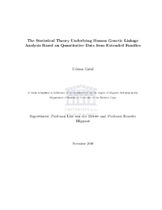The statistical theory underlying human genetic linkage analysis based on quantitative data from extended families
Abstract
Traditionally in human genetic linkage analysis, extended families were only used in the analysis of dichotomous traits, such as Disease/No Disease. For quantitative traits, analyses initially focused on data from family trios (for example, mother, father, and child) or sib-pairs. Recently however, there have been two very important developments in genetics: It became clear that if the disease status of several generations of a family is known and their genetic information is obtained, researchers can pinpoint which pieces of genetic material are linked to the disease or trait. It also became evident that if a trait is quantitative (numerical), as blood pressure or viral loads are, rather than dichotomous, one has much more power for the same sample size. This led to the development of statistical mixed models which could incorporate all the features of the data, including the degree of relationship between each pair of family members. This is necessary because a parent-child pair definitely shares half their genetic material, whereas a pair of cousins share, on average, only an eighth. The statistical methods involved here have however been developed by geneticists, for their specific studies, so there does not seem to be a unified and general description of the theory underlying the methods. The aim of this dissertation is to explain in a unified and statistically comprehensive manner, the theory involved in the analysis of quantitative trait genetic data from extended families. The focus is on linkage analysis: what it is and what it aims to do. There is a step-by-step build up to it, starting with an introduction to genetic epidemiology. This includes an explanation of the relevant genetic terminology. There is also an application section where an appropriate human genetic family dataset is analysed, illustrating the methods explained in the theory sections.

